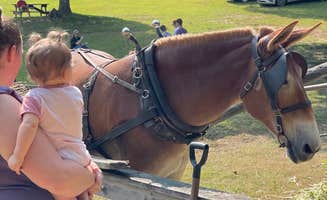Equestrian camping opportunities near Dayton, Tennessee extend throughout the southern Appalachian foothills, with elevations ranging from 700 to 2,000 feet. The region features a humid subtropical climate with average summer temperatures around 85°F and winter lows near 25°F. Several campgrounds in the area maintain dedicated facilities for horses, including corrals, staging areas, and direct access to trail networks.
What to do
Waterfall hiking trails: Fall Creek Falls State Park Campground offers multiple waterfall access points. "So many trails, so little time. One of the best hiking parks I've ever been to. Miles and miles of trails; short, long, loops, overnights. This place has it all. Make sure you do three things while you're there: hike to the bottom of the big waterfall (Fall Creek Falls), swim in the cascades next to the nature center, and stand on the edge of the bluff at Buzzard's Roost," says Myke C.
Creek swimming: Hickey Gap Campground in the Cohutta WMA provides direct access to swimming areas. "This area is easily accessible but can be packed during prime camping season! There is a beautiful waterfall about a mile down trail from camp and tons of great swimming areas!" notes John B.
Overnight trail riding: For equestrian camping near Dayton, Tennessee, the Cottonwood Patch Campground serves as a convenient staging area. "Level spots with picnic tables. Not directly on the river but is accessible. A lot of equestrians stay here but anyone can," reports Bob P. The sites accommodate riders looking for multi-day horse camping experiences.
What campers like
Creek-side sleeping arrangements: Davis Pond Campsite offers waterfront camping. "Down a long and winding (and dusty) gravel road into the WMA is the Davis Pond camp site, a real gem with shady trees and a fishing pond. This lightly developed site has two picnic tables, and two lantern posts near the tables. However, it can easily accommodate many more campers in the space and has multiple dirt-and-rock fire pits," writes William S.
No hookup wilderness experience: Gee Creek Campground near Delano maintains a more rustic camping environment. "The Gee Creek Campground is apart of the Hiwassee/Ocoee State Park. The state park/campground adjoins the Cherokee National Forest and sits on the north bank of the Hiwassee River outside of Benton, TN. The park has a nice size bath house that is heated during the winter," describes Gregg G.
Free camping options: Several equestrian camping areas near Dayton, Tennessee offer no-fee sites. "This spot is super neat! About 45 mins outside Chattanooga, it's a beautiful drive. Last 7 miles are on a windy gravel road. This is what camping should be!! Free, first come first serve, with some fire pits and picnic tables and plenty of room to pitch a tent," shares Tessa B. about Davis Pond.
What you should know
Limited drinking water access: Many horse-friendly campgrounds lack water hookups. "During winter campground is very quiet, no power at sites, it does have hot showers," notes Byron R. about Gee Creek Campground.
Bear safety requirements: Several campgrounds enforce bear-safe food storage. "There was a pit toilet with plenty of toilet paper and it was quite clean. There's also a bear box and signs clearly indicating there are bears around and that you should keep all food in your vehicle or use the box," explains Mike H.


